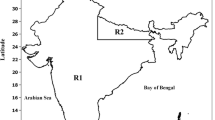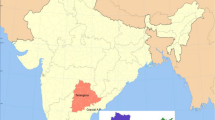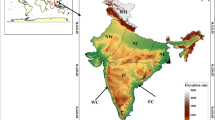Abstract
This work presents the association of flash rate density (FRD) with surface air temperature, rainfall and convective available potential energy (CAPE) using satellite-based flash count grid (0.5° × 0.5°) data from 1998 to 2007 over Maharashtra, India. We investigate monthly to seasonal variations in lightning activity with rainfall and CAPE. The first peaks for FRD and rainfall found in June and July, respectively, followed by next peaks in September. The difference in peaks for FRD and rainfall of 1 month (June–July) attributed to the onset phase of summer monsoon in June (relatively less wet period favorable for more convective and lightning activity), thereafter, heavy rainfall in July over Maharashtra. The annual variations show that the September peaks for both FRD and rainfall are higher than that in June for FRD and for rainfall in July. FRD is moderately correlated with rainfall (r = 0.51 at significant level <0.0001). There is good parallelism in the variation of FRD, and CAPE as the correlation coefficient in between them is 0.78 at significant level <0.0001.








Similar content being viewed by others
References
Balogun EE (1981) Seasonal and spatial variation of thunderstorm activity over Nigeria. Weather 36:192–197
Boccippio D, Goodman SJ, Heckman S (2000) Regional differences in tropical lightning distributions. J Appl Meteorol 39:2231–2248
Boccippio DJ, Koshak WJ, Blakeslee RJ (2002) Performance assessment of the optical transient detector and lightning imaging sensor. Part I: predicted diurnal variability. J Atmos Ocean Technol 19:1318–1332
Bond DW, Steiger S, Zhang R, Tie X, Orville RE (2002) The importance of NOx production by lightning in the tropics. Atmos Environ 36:1509–1519
Cecil DJ, Buechler DE, Blakeslee RJ (2014) Gridded lightning climatology from TRMM-LIS and OTD: dataset description. Atmos Res 135–136:404–414
Chaudhury AK (1961) Premonsoon thunderstorms in Assam, Tripura and Manipur. Indian J Meteorol Geophys 12(1):33–36
Christian HJ, Blakeslee RJ, Goodman SJ, Mach DA, Stewart MF, Buechler DF et al (1999). The lightning imaging sensor. In: Proceeding of 11th International Conference on Atmospheric Electricity, National Aeronautic and Space Administration, Guntersville, vol Al, p 746–749
India Meteorological Department (1931) The structure of the sea-breeze at Poona. Sci Notes 3(30):131–134
India Meteorological Department (2005) Climate of Maharashtra, Publisher. Controller of Publication, Government of India, p 280
Jenamani RK, Bhan SC, Kalsi SR (2006) Observational/forecasting aspects of the meteorological event that caused a record highest rainfall in Mumbai. Curr Sci 90:1344–1362
Kandalgaonkar SS, Tinmaker MIR, Kulkarni JR, Nath A (2003) Diurnal variation of lightning over the Indian region. Geophys Res Lett 30(20):2002. doi:10.1029/2003GL018005
Kandalgaonkar SS, Tinmaker MIR, Kulkarni JR, Nath A, Kulkarni MK (2005a) Spatio-temporal variability of lightning activity over the Indian region. J Geophys Res 110:D11108. doi:10.1029/2004JD005631
Kandalgaonkar SS, Tinmaker MIR, Nath AS, Kulkarni MK, Trimbake HK (2005b) Study of thunderstorm and rainfall activity over the Indian region. Atmosfera 18:91–101
Kandalgaonkar SS, Tinmaker MIR, Kulkarni MK (2008) Two year observational study of lightning and rainfall activity over Maharashtra, India. Int J Meteorol 33:39–48
Koteswaram P, Srinivasan G (1958) Thunderstorm over gangetic west Bengal in the premonsoon season and the synoptic factors favourable for their formation. Indian J Meteorol Geophys 9:301–312
Manohar GK, Kesarkar AP (2005) Climatology of thunderstorm activity over the Indian region: III. Latitudinal and seasonal variation. Mausam 56(3):581–592
Manohar GK, Kandalgaonkar SS, Tinmaker MIR (1999) Thunderstorm activity over India and the Indian southwest monsoon. J Geophys Res 104(D4):4169–4188
Moid SA (1995) A climatological study of thunderstorms at Mohanbari Airport. Mausam 46:202–204
Murugavel P, Pawar SD, Gopalakrishnan V (2014) Climatology of lightning over Indian region and its relationship with convective available potential energy. Int J Climatol. doi:10.1002/joc.3901
Oladipo EO, Mornu ME (1985) Characteristics of thunderstorms in Zaria, Nigeria. Weather 40:316–322
Prasad SK, Pawar BC (1985) Climatological studies of thunderstorm to the west and east of the western ghats in the State of Maharashtra and Goa: part I. Mausam 36:107
Price C, Rind D (1994) Modeling and global lightning distributions in a general circulation model. Mon Weather Rev 122:1930–1939
Raman PK, Raghavan K (1961) Diurnal variation of thunderstorm in India during different seasons. Indian J Meteorol Geophys 12(1):115–130
Rao KN, Raman PK (1961) Frequency of days of thunder in India. Indian J Meteorol Geophys 12:103–108
Rao KN, Dainel CEJ, Pejabi KG (1971) India Met. Dep Pre Publ Sci Rep 154
Rutledge SA, Williams ER, Keenan TD (1992) The down under Doppler and electricity experiment (DUNDEE): overview and preliminary results. Bull Am Meteorol Soc 73:3–16
Sivaramkrishnan TR (1990) An analytical study of thunderstorm over Sriharikota. Mausam 41:489–491
Sohoni VV (1931) Thunderstorm of Calcutta. 1926–1990. Sci Notes 1(5):26–36
Takahashi T (1990) Near absence of lightning in torrential rainfall producing Micronesian thunderstorms. Geophys Res Lett 17:2381–2384
Tinmaker MIR, Ali K, Pawar SD (2010a) Thunderstorm electrical parameter vis-à-vis rainfall and surface air temperatures over a tropical inland station, Pune, India. J Meteorol Soc Jpn 88:915–924
Tinmaker MIR, Ali K, Beig G (2010b) Relationship between lightning activity over Peninsular India and sea surface temperature. J Appl Meteorol Climatol 49:828–835
Williams SD (1961) Frequency of thunderstorms in south India. Indian J Meteorol Geophys 12:131–133
Williams ER (1995) Meteorological aspects of thunderstorms. In: Volland H (ed) CRC handbook on atmospheric electrodynamics, vol 1. CRC Press, Boca Raton, pp 27–60
Williams ER (2001) The electrification of severe storms. In: Severe convective storms, Meteorological Monograph, III edn. vol 28, Doswell, CA, p 527–561
Williams ER, Renno N (1993) An analysis of the conditional instability of the tropical atmosphere. Mon Weather Rev 121:21–36
Williams ER, Satori G (2004) Lightning thermodynamic and hydrological comparison of the two tropical continental chimneys. J Atmos Solar Terr Phys 66:1213–1231
Williams ER, Stanfil S (2002) The physical origin of the land ocean contrast in lightning activity. C R Phys 3:1277–1292
Williams ER, Chan T, Boccippio DJ (2004) Islands as miniature continents: another look at the land-ocean lightning contrast. J Geophys Res 109:D16206
Williams ER, Mushtak V, Rosenfeld D, Goodman S, Boccippio D (2005) Thermodynamic conditions favourable to superlative thunderstorm updraft, mixed phase microphysics and lightning flash rate. Atmos Res 76:288–306
Zipser EJ (1994) Deep cumulonimbus cloud systems in the tropics with and without lightning. Mon Weather Rev 122:1837–1851
Acknowledgments
The authors are thankful to the Director, IITM, Pune, for his kind support and valuable guidance to this work.
Author information
Authors and Affiliations
Corresponding author
Rights and permissions
About this article
Cite this article
Tinmaker, M.I.R., Aslam, M.Y. & Chate, D.M. Lightning activity and its association with rainfall and convective available potential energy over Maharashtra, India. Nat Hazards 77, 293–304 (2015). https://doi.org/10.1007/s11069-015-1589-x
Received:
Accepted:
Published:
Issue Date:
DOI: https://doi.org/10.1007/s11069-015-1589-x




